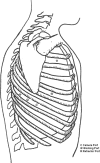Zero leaks with minimally invasive esophagectomy: a team-based approach
- PMID: 20202395
- PMCID: PMC3030789
- DOI: 10.4293/108680809X12589998404326
Zero leaks with minimally invasive esophagectomy: a team-based approach
Abstract
Introduction: Minimally invasive surgery has been applied in several ways to esophagectomy. Newer techniques have improved patient outcomes while maintaining oncological principles; however, mortality still exists. Most series have reported mortality rates ranging from 2% to 25%. The aim of this study was to determine the efficacy of minimally invasive esophagectomies (MIE) in a non-university tertiary care center.
Methods: MIE in the form of a combined thoracoscopic and laparoscopic technique was performed cooperatively by 2 surgeons. Records of patients who underwent MIE between September 2005 and August 2008 were retrospectively reviewed.
Results: Thirty-four patients underwent MIE over a 3-year period. There was a male predominance. Mean age at presentation was 62.6 years. Comorbidities were documented in 79% of the patients. Most patients (68%) presented with dysphagia. Two patients had end-stage achalasia, 1 had corrosive esophageal stricture, and 31 had esophageal malignancies. No mortalities were reported. No anastomotic leaks were observed. Eighteen (58%) patients with malignancy received preoperative chemoradiotherapy. Six (33%) patients had a pathological response (CR) on final histopathology. The mean operating time was 294 minutes. The mean blood loss was 302 mL.
Conclusions: Minimally invasive esophagectomy can be performed with results that meet and exceed reported benchmarks. A team-based approach greatly impacts the outcome of the surgery. This surgical technique must be standardized to achieve this outcome.
Figures
References
-
- Morgan MA, Lewis WG, Hopper AN, et al. Prospective comparison of transthoracic versus transhiatal esophagectomy following neoadjuvant therapy for esophageal cancer. Dis Esophagus. 2007;20(3):225–231 - PubMed
-
- Boyle MJ, Franceschi D, Livingstone AS. Transhiatal versus transthoracic esophagectomy: complication and survival rates. Am Surg. 1999;65(12):1137–1141 - PubMed
-
- Bizekis C, Kent MS, Luketich JD, et al. Initial experience with minimally invasive Ivor Lewis esophagectomy. Ann Thorac Surg. 2006;82(2):402–406 - PubMed
-
- Qureshi I, Nason KS, Luketich JD. Is minimally invasive esophagectomy indicated for cancer? Expert Rev Anticancer Ther. 2008;8(9):1449–1460 - PubMed
-
- Mark B. Orringer, Becky Marshall, Mark D. Iannettoni, Eliminating the cervical esophagogastric anastomotic leak with a side-to-side stapled anastomosis. J Thorac Cardiovasc Surg. 2000;119:277–288 - PubMed
MeSH terms
LinkOut - more resources
Full Text Sources
Medical


